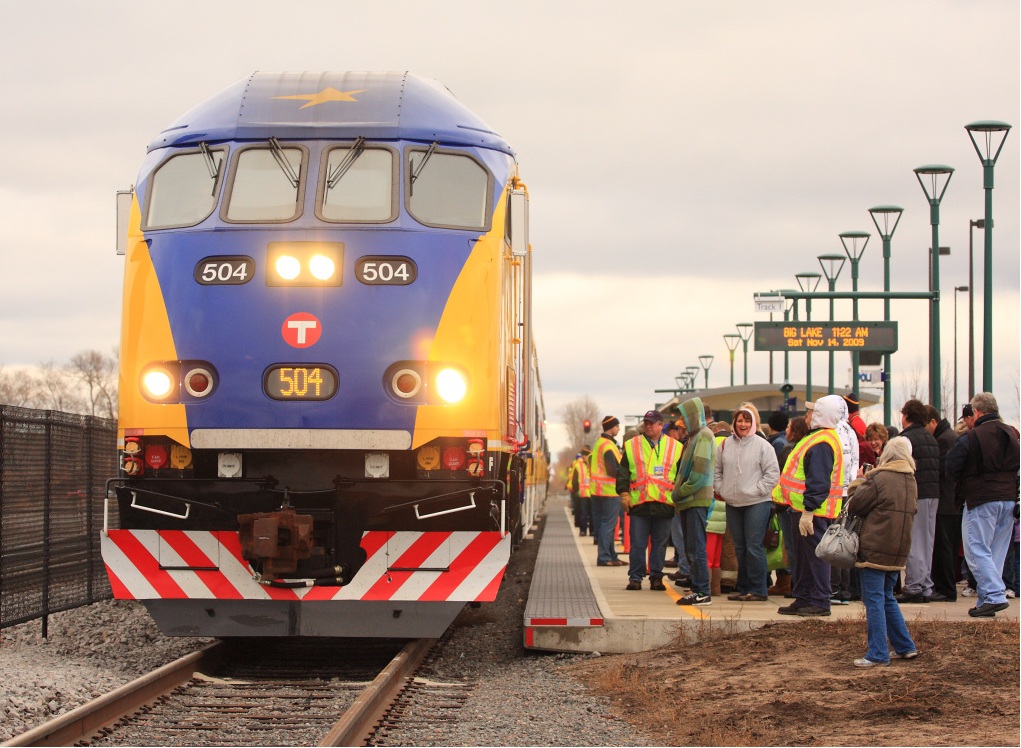
Minneapolis-area Northstar train at Big Lake station (Photo: Nick Benson)
Light Rail Now can be contacted at: Light Rail Now |
Northstar Regional Rail Links Northwest Communities With Central City Susan Pantell With Light Rail Now Project Team • March 2010 High-quality rail transit service, free of traffic congestion, has at last arrived to connect Minneapolis with exurban communities to its northwest. On 16 November 2009, Metro Transit began revenue service for the Northstar regional passenger rail line, running 40 miles (64 km) along the Burlington Northern Santa Fe (BNSF) railroad alignment with stops at six stations: Big Lake, Elk River, Anoka, Coon Rapids-Riverdale, Fridley, and Target Field. In downtown Minneapolis, the Northstar trains connect with the Hiawatha light rail transit (LRT) line at Target Field, the new Minnesota Twins ballpark that will open in 2010.
Five trains run in the peak direction every 30 minutes each weekday morning from Big Lake to Minneapolis, and in the reverse direction in the afternoon. One train in the morning and one in the afternoon run against the peak direction. On weekends, there are three roundtrips each day. The trains speed up to 79 mph (127 km/h), and the total end-to-end trip takes about 50 minutes. Each train is powered by a diesel-electric locomotive with a consist of four passenger cars, each car providing seats for about 140 people. For the service, Metro Transit purchased five diesel-powered MP36PH-3C locomotives from Motive Power, Inc. in Boise, Idaho for $13.8 million, and they purchased seventeen bilevel passenger coaches from Bombardier. [Wikipedia]
Each suburban station has a free park-and-ride lot, for a total of 1,800 spaces, and connecting bus service is provided at four of the surburban stations. A rolling stock maintenance facility is located in Big Lake. About 2,400 one-way trips were made on the first full day of service. Metro Transit estimates that daily ridership will be 3,400 by 2010 and 5,900 by 2030. [Metro Transit, Northstar, Facts and Funding] The fares are $3.25 to $7 each way, depending on the distance traveled. Designed and constructed by the Minnesota Department of Transportation (MnDOT), the Northstar system is now owned by the Metropolitan Council (MC), the regional planning organization for the seven-county Twin Cities area; the MC also runs the regional bus and light rail systems. Northstar is managed and operated by Metro Transit, an operating division of the Metropolitan Council. BNSF conductors and engineers operate the trains. The investment cost of the project totaled $320 million, which was provided by a variety of sources:
According to Metro Transit, adding highway capacity would have been nearly four times as expensive, and a bus rapid transit line would have been nearly six times as expensive. [Metro Transit, Why Build Northstar] Part of the money was used to extend the Hiawatha light rail line to Target Field. New Start rail transit projects tend to be planned with a view to the future. The Northstar corridor, which runs alongside Highway 10 (and roughly parallel to I-94), is a fast-growing area, and the two major highways into downtown Minneapolis are at capacity during peak periods for commuters from the north and northwest. The number of inbound trips to the Minneapolis central business district is expected to increase almost 75% by 2025. [Federal Transit Administration (FTA), New Starts Report, Nov. 2007] Northstar project history In May 1997, thirty counties, cities, townships, and rail and transportation organizations in the region that wanted to address transportation between St. Cloud and Minneapolis formed the Northstar Corridor Development Authority (NCDA), a joint powers authority. MnDOT and NCDA completed a major investment study (MIS) in December 1999 for an 82-mile commuter (regional transit) rail line between Minneapolis and Rice, Minnesota. In June 2000, the Federal Transit Administration (FTA) authorized the project to begin preliminary engineering. Subsequently, NCDA presented to FTA a scaled-back version of the project, proposing a line to run from Minneapolis to Big Lake, and it passed the FTA's cost-effectiveness criteria in December 2003. In the 2005 Minnesota legislation session, a bonding bill was passed that included $37.5 million for the project; and in May 2006, NCDA, the State of Minnesota, and BNSF Railroad reached an agreement to allow the line to use the BNSF tracks. In September 2007, a project to extend the Hiawatha LRT line (in part, to connect with Noprthstar) began, and construction of the Northstar stations began in April 2008. FTA awarded a Full Funding Grant Agreement (FFGA) in December 2007. New siding was added to the track to allow for Northstar, Amtrak's Empire Builder, and freight trains to pass each other, and testing of the trains began in June 2009. [Metro Transit, History of Northstar, and FTA, New Starts Report, Nov. 2007] The project was helped by strong support from Minnesota Congressman Jim Oberstar, bi-partisan support from other Minnesota representatives, and approval from Governor Tim Pawlenty, after he initially opposed the project. Future plans MnDOT and NCDA are planning to extend the Northstar line to Becker and St. Cloud at an additional investment cost of $150 million. Currently, a bus link to St. Cloud is provided. [Star Tribune, 15 Nov. 2009] There are plans for concentrated development near some of the train stations, but actual construction will probably not occur for some years. [Finance and Commerce, 10 Nov. 2009] Nevertheless, it's clear that Northstar is a transportation investment that will be influencing both mobility and development patterns in the region.
Original research and narrative for this article were provided by LRN Research Associate Susan Pantell; additional information and analysis, and final editing, were provided by others on the Light Rail Now Project team. Light Rail Now! website
|
||||
|
|
|||||